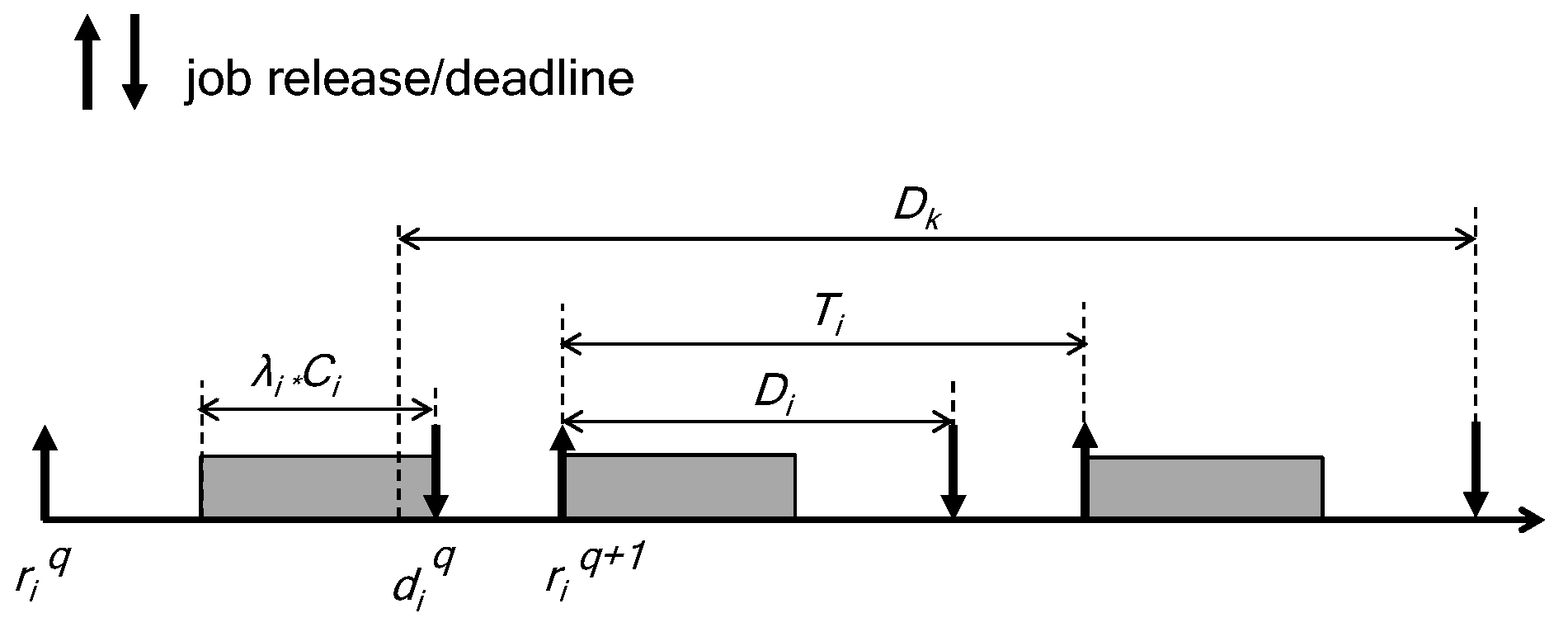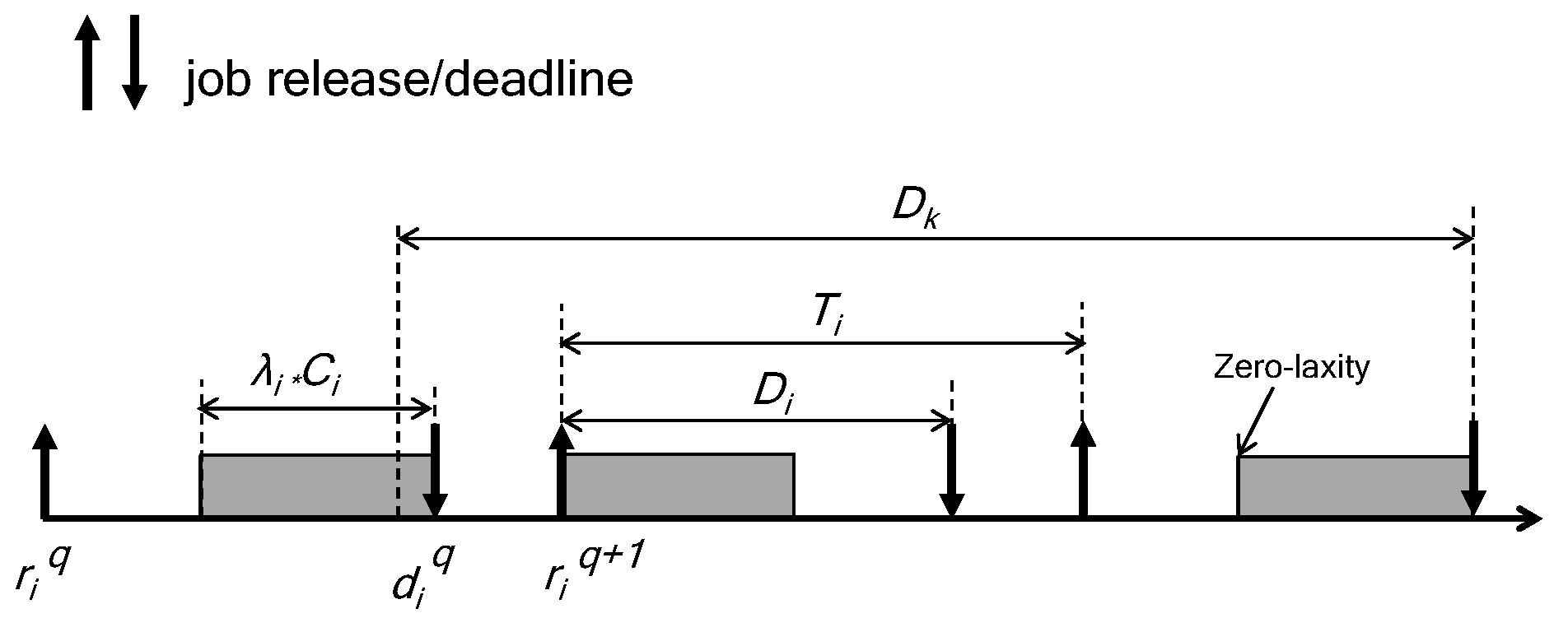Task-Level Re-Execution Framework for Improving Fault Tolerance on Symmetry Multiprocessors
Abstract
1. Introduction
- It proposes the FT policy to improves reliability of the target system scheduled by a given real-time scheduling algorithm without sacrificing schedulability.
- A new deadline-based schedulability analysis designed for the re-execution technique is proposed, which can be incorporated into the FT policy.
- FT policy incorporated into FP and EDZL scheduling are proposed as a case study.
- The conducted experiments demonstrate that the FT policy dramatically improves the performance compared to the existing techniques (utilizing the predetermined ) when we consider the schedulability and reliability simultaneously.
2. The System Model
2.1. The Task Model
2.2. The Fault Model
3. The Fault-Tolerant Scheduling Framework
3.1. The Scheduling Algorithm Incorporating FT Policy
- Q1
- How can of be determined without compromising the schedulability of ?
- Q2
- How can of be determined without compromising the schedulability of the other tasks ?
| Algorithm 1 The FT-policy-incorporated scheduling algorithm. |
| 1: for every is assigned by a given assignment algorithm (Algorithm 2) 2: for Every time instance t do 3: if is released by then 4: Insert into 5: end if 6: Schedule jobs in according to a given base scheduling algorithm 7: if times of executions are completed for , and a fault is detected then 8: Execute again. 9: end if 10: if finishes its execution then 11: Delete from 12: end if 13: end for |
3.2. Schedulability Analysis
3.3. The -Assignment Algorithm
| Algorithm 2-Assignment Algorithm |
| 1: for all tasks 2: for from the first task to the last one selected by a given selection algorithm do 3: while is deemed schedulable by Theorem 1, and holds do 4: 5: end while 6: 7: end for |
4. Case Study
4.1. Schedulability Analysis for FT-FP-A
4.2. Schedulability Analysis for FT-EDZL-A
4.3. Evaluation Environment
- : for the EDZL scheduling algorithm (Equation (14) with every );
- (also denoted by -): for the RM scheduling algorithm (Equation (12) with every ),
- : for the EQDF scheduling algorithm (Equation (12) with every );
- --: for the EDZL scheduling algorithm incorporating the FT policy in which the -assignment algorithm increases in an order of index k (Equation (14) with determined by a given -assignment algorithm);
- --: for the RM scheduling algorithm incorporating the FT policy in which the -assignment algorithm increases in an order of task priority (Equation (12) with determined by a given -assignment algorithm);
- --: for the EQDF scheduling algorithm incorporating the FT policy in which the -assignment algorithm increases in an order of task priority (Equation (12) with determined by a given -assignment algorithm);
- -: for the RM scheduling algorithm (Equation (12) with every );
- -: for the RM scheduling algorithm (Equation (12) with every ).
4.4. Example of a Task Set: ACSW in Satellite Systems
- tHigh retrieves a single macro command (MCMD) from an MCMD queue in every period and invokes a job corresponding to the MCMD.
- tMilbus is responsible for receiving MCMDs from the ground station by utilizing the MIL-STD-1553B protocol [20] and verifies the integrity of each MCMD before the MCMD is inserted into an MCMD queue.
- tOne performs internal mode transitions such as turning on/off relevant equipment and transmits internal telemetries via the SpaceWire protocol [21].
- tTwo conducts various executions such as fault detection, formatting network packets that will be transferred to the ground station.
- tSync executes a job for the operation preparation whenever there are surplus computing resources.
4.5. Evaluation Results
5. Related Work
6. Conclusions
Author Contributions
Funding
Conflicts of Interest
References
- Liu, C.; Layland, J. Scheduling Algorithms for Multi-programming in A Hard-Real-Time Environment. J. ACM 1973, 20, 46–61. [Google Scholar] [CrossRef]
- Ekpo, S.; George, D. A system-based design methodology and architecture for highly adaptive small satellites. In Proceedings of the IEEE International Systems Conference, San Diego, CA, USA, 5–8 April 2010; pp. 516–519. [Google Scholar]
- Malhotra, S.; Narkhede, P.; Shah, K.; Makaraju, S.; Shanmugasundaram, M. A review of fault tolerant scheduling in multicore systems. Int. J. Sci. Technol. Res. 2015, 4, 132–136. [Google Scholar]
- Yu, X.B.; Zhao, J.S.; Zheng, C.W.; Hu, X.H. A Fault-Tolerant Scheduling Algorithm using Hybrid Overloading Technology for Dynamic Grouping based Multiprocessor Systems. Int. J. Comput. Commun. Control 2012, 7, 990–999. [Google Scholar] [CrossRef]
- Zhou, J.; Yin, M.; Li, Z.; Cao, K.; Yan, J.; Wei, T.; Chen, M. Fault-Tolerant Task Scheduling for Mixed-Criticality Real-Time Systems. J. Circuits Syst. Comput. 2017, 26, 1750016. [Google Scholar] [CrossRef]
- Kang, S.; Yang, H.; Kim, S.; Bacivarov, I.; Ha, S.; Thiele, L. Static mapping of mixed critical applications for fault-tolerant MPSoCs. In Proceedings of the IEEE Design Automation Conference (DAC), San Francisco, CA, USA, 1–5 June 2014; pp. 1–6. [Google Scholar]
- Aminzadeh, S.; Ejlali, A. A comparative study of system-level energy management methods for fault-tolerant hard real-time systems. IEEE Trans. Comput. 2011, 60, 1228–1299. [Google Scholar] [CrossRef]
- Bertogna, M.; Cirinei, M.; Lipari, G. Schedulability Analysis of Global Scheduling Algorithms on Multiprocessor Platforms. IEEE Trans. Parallel Distrib. Syst. 2009, 20, 553–566. [Google Scholar] [CrossRef]
- Baker, T.P.; Cirinei, M.; Bertogna, M. EDZL Scheduling Analysis. Real-Time Syst. 2008, 40, 264–289. [Google Scholar] [CrossRef]
- Lee, J.; Easwaran, A.; Shin, I. LLF Schedulability Analysis on Multiprocessor Platforms. In Proceedings of the Real-Time Systems Symposium, San Diego, CA, USA, 30 November–3 December 2010; pp. 25–36. [Google Scholar]
- Bertogna, M.; Cirinei, M.; Lipari, G. Improved Schedulability Analysis of EDF on Multiprocessor Platforms. In Proceedings of the Euromicro Conference on Real-Time Systems (ECRTS), Balearic Islands, Spain, 6–8 July 2005; pp. 209–218. [Google Scholar]
- Bertogna, M.; Cirinei, M. Response-Time Analysis for globally scheduled Symmetric Multiprocessor Platforms. In Proceedings of the IEEE Real-Time Systems Symposium (RTSS), Tucson, AZ, USA, 3–6 December 2007. [Google Scholar]
- Bini, E.; Buttazzo, G.C. The space of rate monotonic schedulability. In Proceedings of the IEEE Real-Time Systems Symposium (RTSS), Austin, TX, USA, 3–5 December 2002. [Google Scholar]
- Back, H.; Chwa, H.S.; Shin, I. Schedulability Analysis and Priority Assignment for Global Job-level Fixed-Priority Multiprocessor Scheduling. In Proceedings of the Real Time and Embedded Technology and Applications Symposium, Beijing, China, 16–19 April 2012; pp. 297–306. [Google Scholar]
- Baker, T.P. Comparison of Empirical Success Rates of Global vs. Partitioned Fixed-Priority EDF Scheduling for Hard Real-Time; Technical Report TR–050601; Department of Computer Science, Florida State University: Tallahassee, FL, USA, 2005. [Google Scholar]
- Andersson, B.; Bletsas, K.; Baruah, S. Scheduling Arbitrary-Deadline Sporadic Task Systems on Multiprocessor. In Proceedings of the IEEE International Conference on Embedded and Real-Time Computing Systems and Applications, Barcelona, Spain, 30 November–3 December 2008; pp. 197–206. [Google Scholar]
- Lee, J.; Easwaran, A.; Shin, I. Contention-Free Executions for Real-Time Multiprocessor Scheduling. ACM Trans. Embed. Comput. Syst. 2014, 13, 1–69. [Google Scholar] [CrossRef]
- Baek, H.; Lee, H.; Lee, H.; Lee, J.; Kim, S. Improved Schedulability Analysis for Fault-Tolerant Space-Borne SAR System. In Proceedings of the Conference on Korea Institute of Military Science and Technology (KIIT), Deajeon, Korea, 7–8 June 2018; pp. 1231–1232. [Google Scholar]
- RTEMS Community. RTEMS Real-Time Operating System. Available online: https://www.rtems.org (accessed on 9 May 2019).
- Excalibur Systems. MIL-STD-1553B. Available online: https://www.mil-1553.com (accessed on 9 May 2019).
- European Space Agency. SpaceWire. Available online: http://spacewire.esa.int (accessed on 9 May 2019).
- Ghosh, S.; Melhem, R.; Mosse, D. Fault-tolerance through scheduling of aperiodic tasks in hard real-time multiprocessor systems. IEEE Trans. Parallel Distrib. Syst. 1997, 8, 272–284. [Google Scholar] [CrossRef]
- Manimaran, G.; Murthy, C.S.R. A fault-tolerant dynamic scheduling algorithm for multiprocessor real-time systems and its analysis. IEEE Trans. Parallel Distrib. Syst. 1998, 9, 1137–1152. [Google Scholar] [CrossRef]
- Al-Omari, R.; Somani, A.K.; Manimaran, G. Efficient overloading techniques for primary-backup scheduling in real-time systems. J. Parallel Distrib. Comput. 2004, 64, 629–648. [Google Scholar] [CrossRef]
- Cirinei, M.; Bini, E.; Lipari, G.; Ferrari, A. A Flexible Scheme for Scheduling Fault-Tolerant Real-Time Tasks on Multiprocessors. In Proceedings of the IEEE International Parallel and Distributed Processing Symposium, Rome, Italy, 26–30 March 2007; pp. 1–8. [Google Scholar]
- Liberato, F.; Lauzac, S.; Melhem, R.; Mosse, D. Fault tolerant real-time global scheduling on multiprocessors. In Proceedings of the Euromicro Conference on Real-Time Systems (ECRTS), York, UK, 9–11 June 1999; pp. 252–259. [Google Scholar]





| WCET | BCET | ACET | |||
|---|---|---|---|---|---|
| tHigh | 62.5 | 50 | 2.98 | 0.08 | 0.14 |
| tMilbus | 125 | 100 | 0.54 | 0.11 | 0.21 |
| tOne | 250 | 200 | 30.08 | 0.05 | 0.29 |
| tTwo | 500 | 400 | 231.72 | 37.7 | 147.5 |
© 2019 by the authors. Licensee MDPI, Basel, Switzerland. This article is an open access article distributed under the terms and conditions of the Creative Commons Attribution (CC BY) license (http://creativecommons.org/licenses/by/4.0/).
Share and Cite
Baek, H.; Lee, J. Task-Level Re-Execution Framework for Improving Fault Tolerance on Symmetry Multiprocessors. Symmetry 2019, 11, 651. https://doi.org/10.3390/sym11050651
Baek H, Lee J. Task-Level Re-Execution Framework for Improving Fault Tolerance on Symmetry Multiprocessors. Symmetry. 2019; 11(5):651. https://doi.org/10.3390/sym11050651
Chicago/Turabian StyleBaek, Hyeongboo, and Jaewoo Lee. 2019. "Task-Level Re-Execution Framework for Improving Fault Tolerance on Symmetry Multiprocessors" Symmetry 11, no. 5: 651. https://doi.org/10.3390/sym11050651
APA StyleBaek, H., & Lee, J. (2019). Task-Level Re-Execution Framework for Improving Fault Tolerance on Symmetry Multiprocessors. Symmetry, 11(5), 651. https://doi.org/10.3390/sym11050651






